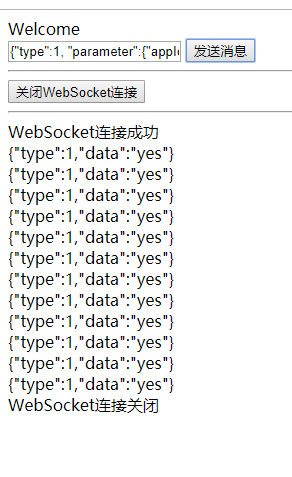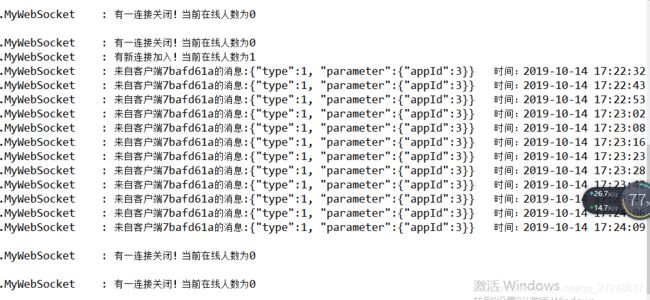Spring boot 2基于Netty的高性能Websocket服务器(心跳模式)
1:为什么要用Netty
Netty是一款基于NIO(Nonblocking I/O,非阻塞IO)开发的网络通信框架,对比于BIO(Blocking I/O,阻塞IO),他的并发性能得到了很大提高;Netty的传输快其实也是依赖了NIO的一个特性——零拷贝。我们知道,Java的内存有堆内存、栈内存和字符串常量池等等,其中堆内存是占用内存空间最大的一块,也是Java对象存放的地方,一般我们的数据如果需要从IO读取到堆内存,中间需要经过Socket缓冲区,也就是说一个数据会被拷贝两次才能到达他的的终点,如果数据量大,就会造成不必要的资源浪费。
Netty针对这种情况,使用了NIO中的另一大特性——零拷贝,当他需要接收数据的时候,他会在堆内存之外开辟一块内存,数据就直接从IO读到了那块内存中去,在netty里面通过ByteBuf可以直接对这些数据进行直接操作,从而加快了传输速度
2:官方中文文档
官方文档
3: Netty-websocket-spring-boot-starter
这是个开源的框架。通过它,我们可以像spring-boot-starter-websocket一样使用注解进行开发,只需关注需要的事件(如OnMessage)。并且底层是使用Netty,netty-websocket-spring-boot-starter其他配置和spring-boot-starter-websocket完全一样,当需要调参的时候只需要修改配置参数即可,无需过多的关心handler的设置
4:Maven 依赖
要求 JDK 1.8
org.yeauty
netty-websocket-spring-boot-starter
0.8.0
5:创建MyWebSocket类
此处为官方文档给的实例
@ServerEndpoint
@Component
public class MyWebSocket {
@OnOpen
public void onOpen(Session session, HttpHeaders headers, ParameterMap parameterMap) throws IOException {
System.out.println("new connection");
String paramValue = parameterMap.getParameter("paramKey");
System.out.println(paramValue);
}
@OnClose
public void onClose(Session session) throws IOException {
System.out.println("one connection closed");
}
@OnError
public void onError(Session session, Throwable throwable) {
throwable.printStackTrace();
}
@OnMessage
public void onMessage(Session session, String message) {
System.out.println(message);
session.sendText("Hello Netty!");
}
@OnBinary
public void onBinary(Session session, byte[] bytes) {
for (byte b : bytes) {
System.out.println(b);
}
session.sendBinary(bytes);
}
@OnEvent
public void onEvent(Session session, Object evt) {
if (evt instanceof IdleStateEvent) {
IdleStateEvent idleStateEvent = (IdleStateEvent) evt;
switch (idleStateEvent.state()) {
case READER_IDLE:
System.out.println("read idle");
break;
case WRITER_IDLE:
System.out.println("write idle");
break;
case ALL_IDLE:
System.out.println("all idle");
break;
default:
break;
}
}
}
}
此处为本人项目部分源码
package org.springblade.websocket;
import java.io.IOException;
import java.time.LocalDateTime;
import java.time.format.DateTimeFormatter;
import java.util.Date;
import java.util.Timer;
import java.util.TimerTask;
import java.util.concurrent.ExecutorService;
import java.util.concurrent.Executors;
import org.slf4j.Logger;
import org.slf4j.LoggerFactory;
import org.springframework.stereotype.Component;
import org.yeauty.annotation.OnBinary;
import org.yeauty.annotation.OnClose;
import org.yeauty.annotation.OnError;
import org.yeauty.annotation.OnEvent;
import org.yeauty.annotation.OnMessage;
import org.yeauty.annotation.OnOpen;
import org.yeauty.annotation.ServerEndpoint;
import org.yeauty.pojo.ParameterMap;
import org.yeauty.pojo.Session;
import com.alibaba.fastjson.JSON;
import com.alibaba.fastjson.JSONObject;
import io.netty.handler.codec.http.HttpHeaders;
import io.netty.handler.timeout.IdleStateEvent;
@ServerEndpoint(prefix = "netty-websocket")
@Component
public class MyWebSocket {
private static final Logger logger = LoggerFactory.getLogger(MyWebSocket.class);
//静态变量,用来记录当前在线连接数。应该把它设计成线程安全的。
private static int onlineCount = 0;
//定时器
private Timer timer;
//心跳检验
private volatile boolean isPong;
//线程
private ExecutorService executor = Executors.newFixedThreadPool(Runtime.getRuntime().availableProcessors());
public MyWebSocket() {
this.timer = new Timer();
this.isPong = true;
}
/**
* 当有新的WebSocket连接进入时,对该方法进行回调 注入参数的类型:Session、HttpHeaders、ParameterMap
* @param session
* @param headers
* @param parameterMap
* @throws IOException
*/
@OnOpen
public void onOpen(Session session, HttpHeaders headers, ParameterMap parameterMap) throws IOException {
String paramValue = parameterMap.getParameter("paramKey");
//在线数加1
addOnlineCount();
//心跳连接
timer.schedule(new TimerTask() {
@Override
public void run() {
try {
if (isPong) {
//服务没有断开
String message = "{\"type\":1,\"data\":\"yes\"}";
session.sendText(message);
isPong = false;
} else {
onClose(session);
this.cancel();
}
} catch (IOException e) {
e.printStackTrace();
this.cancel();
}
}
}, 0, 10 * 1000);
logger.info("有新连接加入!当前在线人数为" + getOnlineCount());
}
/**
* 当有WebSocket连接关闭时,对该方法进行回调 注入参数的类型:Session
* @param session
* @throws IOException
*/
@OnClose
public void onClose(Session session) throws IOException {
System.out.println("one connection closed");
//在线数减1
if(onlineCount>0) {
subOnlineCount();
}
session.close();
logger.info("有一连接关闭!当前在线人数为" + getOnlineCount());
}
/**
* 当有WebSocket抛出异常时,对该方法进行回调 注入参数的类型:Session、Throwable
* @param session
* @param throwable
*/
@OnError
public void onError(Session session, Throwable throwable) {
throwable.printStackTrace();
session.close();
}
/**
* 当接收到字符串消息时,对该方法进行回调 注入参数的类型:Session、String
* @param session
* @param message {"type":13, "parameter":{"appId":3}}
*/
@OnMessage
public void onMessage(Session session, String message) {
logger.info("来自客户端" + session.channel().id() + "的消息:" + message +" 时间:"+ LocalDateTime.now().format(DateTimeFormatter.ofPattern("yyyy-MM-dd HH:mm:ss")));
//接收消息
JSONObject jsonObject = JSON.parseObject(message);
int type = jsonObject.getInteger("type");
//服务端主动向服务端推送信息
if(getOnlineCount()==0) {
return;
}
//类型为1 设为心跳检测
if(type == 1) {
this.isPong=true;
}else {
if(session.isOpen()) {
executor.submit(new Runnable() {
@Override
public void run() {
JSONObject parameter=jsonObject.getJSONObject("parameter");
session.sendText("Hello Netty!" +parameter.getString("appId"));
}
});
logger.info("---》websocket发送消息成功!!!ID--》" + session.channel().id());
}
}
}
/**
* 当接收到二进制消息时,对该方法进行回调 注入参数的类型:Session、byte[]
* @param session
* @param bytes
*/
@OnBinary
public void onBinary(Session session, byte[] bytes) {
for (byte b : bytes) {
System.out.println(b);
}
session.sendBinary(bytes);
}
/**
* 当接收到Netty的事件时,对该方法进行回调 注入参数的类型:Session、Object
* @param session
* @param evt
*/
@OnEvent
public void onEvent(Session session, Object evt) {
if (evt instanceof IdleStateEvent) {
IdleStateEvent idleStateEvent = (IdleStateEvent) evt;
switch (idleStateEvent.state()) {
case READER_IDLE:
System.out.println("read idle");
break;
case WRITER_IDLE:
System.out.println("write idle");
break;
case ALL_IDLE:
System.out.println("all idle");
break;
default:
break;
}
}
}
private static synchronized int getOnlineCount() {
return onlineCount;
}
private static synchronized void addOnlineCount() {
MyWebSocket.onlineCount++;
}
private static synchronized void subOnlineCount() {
MyWebSocket.onlineCount--;
}
}
打开WebSocket客户端,连接到ws://127.0.0.1:80
此处IP地址为默认的,在实际的开发业务中需要改变,所以可以根据官方文档给的实例进行配置
@ServerEndpoint(prefix = "netty-websocket")
@Component
public class MyWebSocket {
---------
}
配置文件配置application.properties/application.yml
netty-websocket.host=0.0.0.0
netty-websocket.path=/
netty-websocket.port=80
其他的还有很多配置项 ,可以按照实际业务需求自己加上就行

